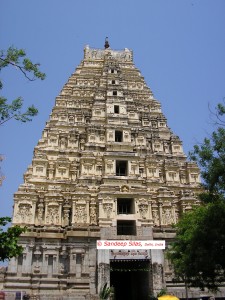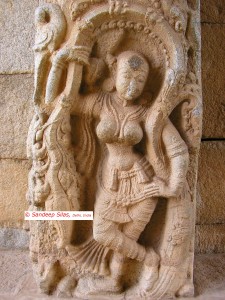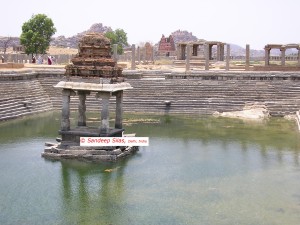There are some people in the world who dream and forget; there are those who dream and dare.
Hampi, the last capital of the great Vijayanagar kingdom was one such dream. In this dream of the King, there was nothing missing—palaces, temples, baths, water tanks, market, platform to watch festivities, watch towers, elephant stables, long covered corridors, aqueducts and fortifications. And this was not bare. Each pillar of a palace or a temple’s gopuram and vimana, doorway, passage, was affectionately adorned with statues of gods, goddesses, humans and animals. The roof was a story in itself—on it was painted a legend or a complete scene. A 15th century muslim envoy, Abdul Razaq, was forced by the beauty of Hampi to remark—“The city is such that the pupil of the eye has never seen a place like it, and the ear of intelligence has never been informed that there existed anything to equal it in the world”. The historians, Nuniz and Paes, praised the city as being greater than Rome, its palaces plated with jewel encrusted gold, simply ‘the best provided city in the world.’

First, to the name Hampi. It is said that Goddess Hampi (Parvati) attained Lord Shiva on the banks of the River Tungabhadra that flows through Hampi.

On her name lives the city and now the World Heritage Site. There is a Ramayana connection also with Hampi. It was originally known as Kishkindha, the monkey kingdom of the great monkey faced King Sugriva, who assisted Lord Rama in the fight against demon King Ravana of Lanka. Later, two brothers, Hakka and Bukka raised Hampi to a city in AD 1336. In the centuries that followed Vijayangar Kingdom surpassed all others in wealth, fame and status between the 14th and 16th centuries.
When I first arrived in the vicinity of Hampi, I was struck by the sheer beauty of the landscape strewn with boulders. Amazing shapes and designs peeped out of most naturally placed boulders.

How an earth could a heavy boulder be resting for ages on a smaller one? How could the wind and rain have shaped another like a pillar? How could two huge rocks be so moved to rest in a standing position converged at the top? There was despair and hope, both written across the landscape by the boulders.
The approach to the main living shrine, the Virupaksha Temple is across a hill. Dropped in the midst of the market place, the erstwhile Hampi Bazaar, I was moved to view with awe the sheer magnificence of the temple gopuram. In those days the gopurams used to tower above the earth.

Built in pyramidal style, profusely ornamented by statues of gods, goddesses and attendant females, this one makes you feel so alive.

Statues of voluptuous females with slender waists, adorned with ornaments, fill up corners of the rising structure. They reveal the concept of beauty and the popular style of jewellery worn in the period. Should your look be a lingering one, there is a possibility that life may fill up the statue and she may come towards you!

A group of women, walking in a row of three, dressed up in the colours of the Indian flag, marched decisively towards the shrine for worship. On their heads was carried puja material and an offering of coconut. They had a band of dancers and drummers following as accompanists. The whole atmosphere was charged.

The presiding deity inside the shrine is Shiva, represented by the lingam. Sprinkled flowers, coconut water, ritual of aarti performed by a flame of fire and the smell of incense completed the picture of worship in an Indian temple. Heads bowed, prayers were offered and the devotees trooped out on the other side.

I stopped to look at the frescoes on the ceiling. The colours have faded but the scene of Shiva’s marriage with Parvati is still visible in its completeness. The celebration is painted in natural colours and comes out with a vibrance that is visible unmistakably in the poise and the eyes of the godly couple.

Out of the temple, I climbed up the bend and halted at the monolith Ganesha. He sits inside the room in his glory while in the pillared hall outside dance maidens on the many pillars, their movement frozen in stone. I move further to a large green arena at one end of which is another Ganesha, much smaller, but sitting in the same style, gazing at the pillared hall in front. A nondescript road takes me further to the Ugra Narsimha.

Again a monolith statue, it now stands alone, as the structure above it was perhaps victim of pillage and destruction at the hands of invaders. The 6-7 meter tall Lakshmi Narasimha has an angered look on his face as he determinedly sits cross-legged. Just next to it is a small round tank, roof open, in the midst of which is a huge rock lingam, the Badavilinga. The water was still and sunlight opened a window on the water surface, half bathing the lingam with light.

I resumed my exploration as I entered the Hazara Rama Temple. The gopuram here is much smaller in dimension and rather full of signs of decay. Two amazing statues of women in dance poise, I caught on the sides as I entered the gate.

Just outside on the other side of the road is a water tank with steps leading down to the water. A covered corridor resting on pillars runs around reminiscent of the style of the Great Roman Baths.

More surprise followed later as I stood face to face with the first stone chariot I had ever seen in the Vithala Temple precincts.

Drawn by miniature elephants it is elaborately carved and has stone wheels that actually move. A ladder is placed in front to enter the chariot.
The biggest wonder is caged in the 56 elaborately carved hollow pillars of this temple. These emit different musical notes! Ever heard of musical notes emanating from stone pillars?

I tapped on one, then another, yet another dazed in ear and eye. How could music be caged in stone? What combination of arithmetic and art was employed to make them sound different and yet combine like in an orchestra? It is sound engineering of the highest order! It is a musical offering of stone to the gods! What better way to please the gods in heavens above! India in any case worships 33 crore deities so the music from these stone pillars will have to emanate equal numbers of days even if it is for one god each day!
The master craftsmen of Hampi, the master musician, and of course the vision of the King as the one who conceptualized the entire setting deserve kudos. I must mention the name of the great King Krishnadevaraya to whom Hampi owes much of its magnificent buildings.

A signage calling aloud ‘Lotus Mahal’ moved our steps. There was an outer wall blocking the view of the interior buildings. This indicated that it was the preserve of the Queen and other ladies.
Inside was a water tank to the right now overgrown with weed and wedded to neglect. To the left a platform is reminder of the royal ladies watching the Mahanavmi celebrations from its vantage position. On both sides of the enclosure are watch-towers, placed diagonally, from where eunuchs guarded the ladies of the Mahal.

In the center of the garden is an exquisite palace, called Lotus Mahal, residence of the Chief Queen.

Two storeyed, carved archways running through, ornamented on the exterior like the dress of a bride, the Mahal has a certain delicacy about it that pleases. It is said that this building was inspired by the beauty of a woman!
A strong desire to see the magic of Hampi come alive, filled up my mind. In my imagination water started filling up the tank, the rustle of silk in Lotus Mahal and oh, those dainty whispers, started wafting out. Soon the caparisoned elephants started lining up outside and eunuchs busied themselves. Dusk was approaching and earthen lamps were lighted all around, their flame protected by the niches that housed them in the walls.

There is no light more romantic than that of diya! When hundreds of them spring to life all about you there is no escaping their warmth. The Mahanavami Dibba became a focal point as royal ladies assembled there to watch fireworks in the city. The sky was soon ablaze with colours and so were the hearts of those who secretly desired someone.
The ruins of Hampi possess a power to captivate the mind’s eye and enthrall a visitor by the warmth of their images that are captive of the times that have gone by.

I walked out on the other side of the ladies enclosure and came to two huge buildings, one used then for the elephants as a stable, and one for their masters.

Further beyond are three small buildings, one of which my guide tells me was the massage and beauty treatment house for the royal ladies!
You hear more stories as you explore more. The King’s Balance is a place where the King was weighed in grain or gold that went for distribution to the poor. The Queen’s Bath is a lovely tank surrounded by arched corridors and lotus shaped fountains under which frolicked the royal ladies.
More excavations are revealing more facets of city life. The Muslim Sultans of the Deccan combined in war frenzy in 1565 AD and attacked this Hindu Kingdom. What followed was destruction, plunder and loot. Somebody won, somebody lost and Hampi was finished forever.
The river Tungabhadra crosses the Hampi valley meandering over rocks and becoming the silver line of this cloud. The river banks at Anegundi village are haven for tourists who wish to stay more at Hampi seeping slowly the beauty of the plundered city. The fortress town of Anegundi is trying to bravely revive the traditional arts of Hampi and the effort is laudable.

Yet in its ruins, those survived, there is a truth written all over; the truth of human endeavor, the truth of human beauty and excellence.

What Time then buried, Time is now revealing in faint blips of ecstasy and wonder!
Please follow and like us:
![BEAUTIFUL THOUGHTS by [Silas, Sandeep]](https://images-eu.ssl-images-amazon.com/images/I/51T%2BzYeK4uL.jpg)













































